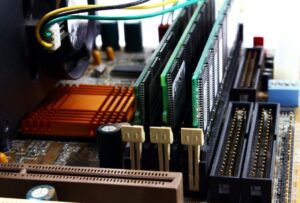What Are AI Model Parameters
Artificial Intelligence (AI) algorithms rely on various parameters to make accurate predictions and decisions. These parameters form the backbone of AI models and are crucial for fine-tuning the performance of machine learning algorithms.
Key Takeaways:
- AI model parameters are essential for fine-tuning machine learning algorithms.
- There are two types of AI model parameters: hyperparameters and learned parameters.
- Hyperparameters control the behavior of the learning algorithm.
- Learned parameters are derived through training and improve the model’s accuracy.
AI models consist of two types of parameters: hyperparameters and learned parameters. Hyperparameters are crucial settings that control the behavior of the learning algorithm and are set by the AI engineer before the training process begins. Examples of hyperparameters include the learning rate, batch size, and number of hidden layers in a neural network.
*Interesting sentence:* By tweaking hyperparameters, AI engineers can optimize the model’s efficiency and enhance accuracy.
On the other hand, learned parameters are parameters that are optimized during the training phase. These parameters are derived from the input data and define the model’s internal representation. For example, in a linear regression model, the learned parameters are the coefficients and intercept that define the relationship between the input features and the target variable.
*Interesting sentence:* Through iterative optimization, AI models automatically find the best values for the learned parameters to minimize the error between the predicted output and the actual output.
Hyperparameters vs. Learned Parameters
To understand the difference between hyperparameters and learned parameters, let’s break it down further:
| Hyperparameters | Learned Parameters |
|---|---|
| Control the behavior of the learning algorithm | Derived through training |
| Set by the AI engineer | Optimized during training |
| Examples: learning rate, batch size, number of hidden layers | Examples: coefficients, intercepts, weights |
*Interesting sentence:* The fine-tuning of hyperparameters requires careful consideration and experimentation to achieve optimal model performance.
The Importance of Model Parameter Tuning
Proper model parameter tuning is essential for achieving the best performance from an AI model. By adjusting hyperparameters, AI engineers can enhance the model’s ability to learn from the data and make accurate predictions. Hyperparameter tuning involves finding the optimal values for the hyperparameters that result in the highest performance metrics.
*Interesting sentence:* Hyperparameter tuning can be a time-consuming and iterative process, requiring multiple experiments to find the optimal parameter values for each specific dataset and problem.
Additionally, the fine-tuning of learned parameters ensures that the model can accurately represent the underlying patterns in the data. Through training, the model learns the best values for these parameters, allowing it to make more accurate predictions over time.
To summarize, AI model parameters play a crucial role in the performance and accuracy of machine learning models. Hyperparameters control the behavior of the learning algorithm, while learned parameters are optimized during training and define the model’s internal representation. The fine-tuning of these parameters is essential for achieving optimal performance and accurate predictions.

Common Misconceptions
1. AI models have too many parameters
One common misconception about AI model parameters is that they have an excessive number that makes the models too complex. However, this is not always the case. While it is true that some AI models can have millions or even billions of parameters, not all models require such a large number. Many AI models are designed to be lightweight and efficient, with a relatively small number of parameters.
- AI models can have both small and large parameter sizes depending on the specific use case.
- The number of parameters is often determined by the complexity of the task the model is trying to solve.
- AI models with fewer parameters can still achieve impressive performance when properly optimized.
2. More parameters always mean better performance
Another common misconception is that increasing the number of parameters in an AI model always leads to better performance. While it is true that having more parameters can potentially increase the learning capacity of a model, it does not guarantee improved performance. In fact, increasing the number of parameters beyond a certain threshold can sometimes lead to overfitting, where the model becomes too specialized to the training data and fails to generalize well.
- The performance of an AI model depends on various factors, not just the number of parameters.
- Models with fewer parameters can achieve comparable or even better performance by using other techniques like regularization and transfer learning.
- Choosing the right balance between model complexity and performance is crucial for effective AI development.
3. Understanding and tuning parameters requires advanced mathematical knowledge
Many people assume that understanding and tuning AI model parameters requires advanced mathematical knowledge. While a solid understanding of mathematics and statistics can be beneficial for optimizing AI models, it is not always a prerequisite. With the advancement of user-friendly deep learning frameworks and tools, even individuals without extensive mathematical backgrounds can effectively work with AI models and tune their parameters.
- Modern deep learning libraries provide high-level APIs that abstract away the complex mathematics behind AI models.
- Online resources and tutorials make it easier for beginners to learn about AI model parameter tuning.
- Gradual learning and hands-on experience can be just as valuable as formal mathematical training when it comes to parameter optimization.
4. AI model parameters are fixed once the model is trained
It is commonly assumed that AI model parameters are fixed once the model is trained and cannot be modified. However, this is not entirely true. While it is true that the learned parameters represent the knowledge and understanding the model has gained during training, they can still be fine-tuned or updated after training in certain scenarios.
- Transfer learning allows pre-trained models to be adapted to new tasks by updating some of their parameters.
- Regularization techniques can be used to adjust the importance of different parameters in the model, even after training.
- Continual learning approaches enable models to learn incrementally and adapt their parameters to new data.
5. AI model parameters determine ethical bias and fairness
There is a misconception that AI model parameters alone determine the ethical bias and fairness of the model’s predictions. While it is true that decision boundaries and feature importance can be influenced by model parameters, ethical bias and fairness are complex and multifaceted issues that go beyond the parameters themselves.
- Training data and preprocessing steps significantly impact the fairness and ethical concerns of AI models.
- Fairness-aware training techniques, such as balancing the dataset or using fairness metrics, can mitigate bias even with fixed parameters.
- Ensuring ethical AI requires thoughtful consideration of the entire pipeline, from data collection to decision-making processes, in addition to model parameters.

The Importance of Learning Rate in AI Model Training
One of the crucial factors affecting the performance of AI models is the learning rate. This parameter determines the step size at which the model adjusts its weights during training. Choosing an optimal learning rate can significantly impact the convergence and accuracy of the model. In this article, we explore the effects of different learning rates on the training of AI models.
Impact of Batch Size on AI Model Training
The batch size is another parameter that greatly influences the training process of AI models. It refers to the number of data samples used in each iteration. The choice of batch size affects the speed of convergence and the quality of the trained model. In this table, we examine how different batch sizes affect the training time and model accuracy.
Exploring the Effect of Activation Functions
The choice of activation function plays a vital role in determining the non-linearity and expressive power of AI models. Different activation functions have unique characteristics that can impact the performance of the model. In the table below, we compare the performance of commonly used activation functions on various classification tasks.
Regularization Techniques for AI Model Generalization
To prevent overfitting and enhance the generalization ability of AI models, regularization techniques are employed. These techniques help control the complexity of the model by adding penalties to the loss function. In this table, we evaluate the effectiveness of different regularization techniques.
Effect of Dropout Probability on Model Performance
Dropout is a regularization technique that randomly sets a fraction of input units to zero during training. This approach helps prevent overfitting and improves the robustness of the model. In the table presented below, we analyze the effect of varying dropout probabilities on model performance.
Comparison of Optimizers in AI Model Training
Optimizers are algorithms used to update the parameters of AI models during training. Various optimizers have different update rules that can significantly impact the training process. In this table, we compare the performance of commonly used optimizers on a specific image classification task.
Investigating the Number of Layers in Deep Neural Networks
The depth of a neural network, determined by the number of layers, is a critical architectural parameter. Deep networks have the potential to learn complex patterns, but too many layers can lead to overfitting. In the table below, we explore the impact of varying the number of layers on model accuracy.
Comparing Loss Functions for AI Model Optimization
Loss functions quantify the dissimilarity between predicted and actual values in AI models. Different loss functions are suitable for specific tasks and learning objectives. In this table, we compare the performance of commonly used loss functions on a regression task.
Effect of Neural Network Initialization Methods
The initialization of neural networks greatly affects their ability to converge and avoid getting trapped in suboptimal solutions. Various initialization methods exist, each with its impact on training dynamics. In the table below, we evaluate the effectiveness of different initialization methods on model convergence.
Comparing Performance Metrics for AI Model Evaluation
When assessing the performance of AI models, various metrics are used to measure their accuracy and generalization capabilities. Different metrics provide insights into different aspects of model performance. In this table, we compare the performance of common evaluation metrics on a text classification task.
Throughout this article, we have explored several key parameters and aspects that greatly influence the training and performance of AI models. By understanding these factors and carefully tuning the model parameters, we can strive to create models that achieve high accuracy and robustness across a wide range of tasks and domains.
What Are AI Model Parameters
Frequently Asked Questions
What are AI model parameters?
How are AI model parameters determined?
What is the significance of AI model parameters?
Can AI model parameters be modified after training?
How do AI model parameters affect the model’s performance?
What are hyperparameters in AI models?
How do hyperparameters differ from model parameters?
What happens if AI model parameters are not properly initialized?
Are all AI model parameters equally important?
Can AI model parameters be interpreted or understood by humans?




